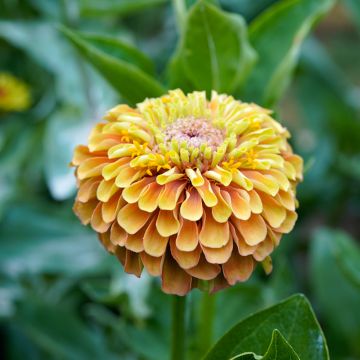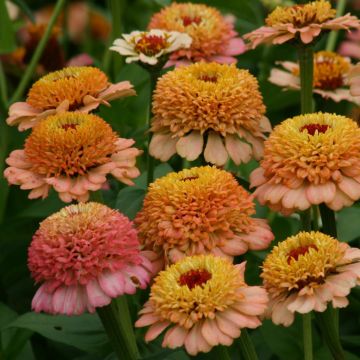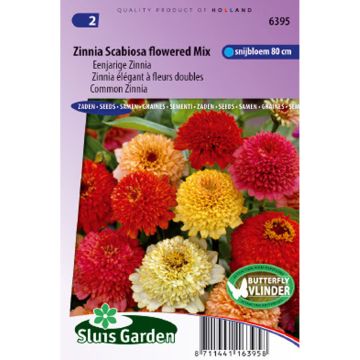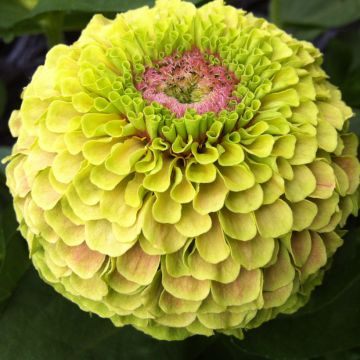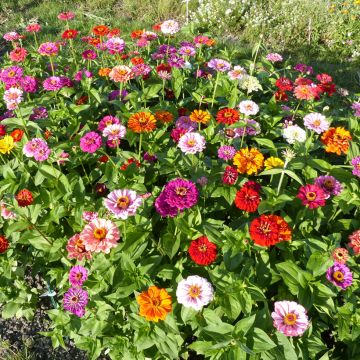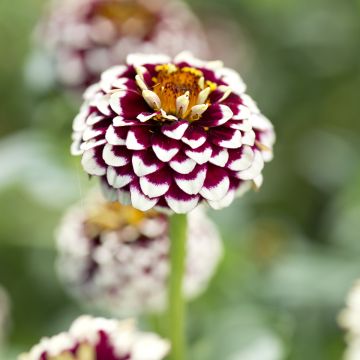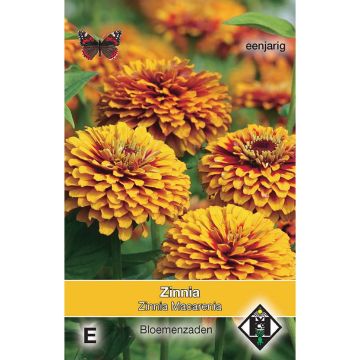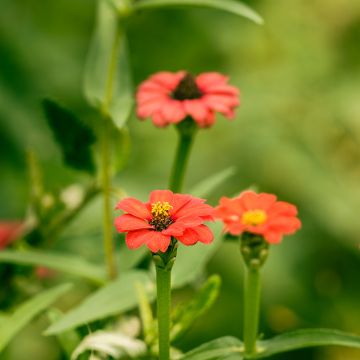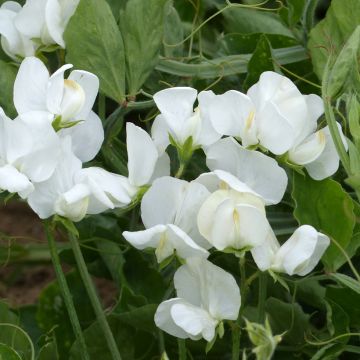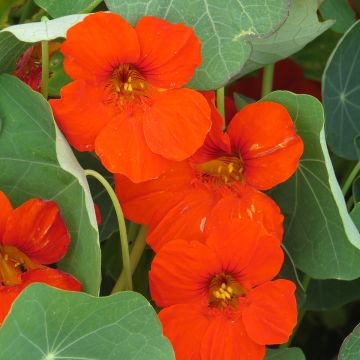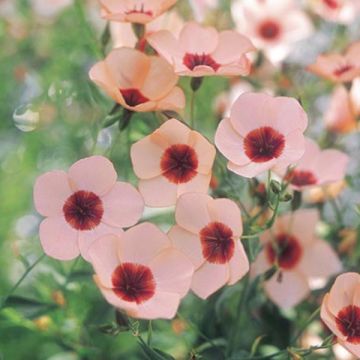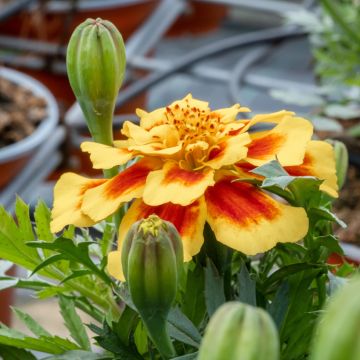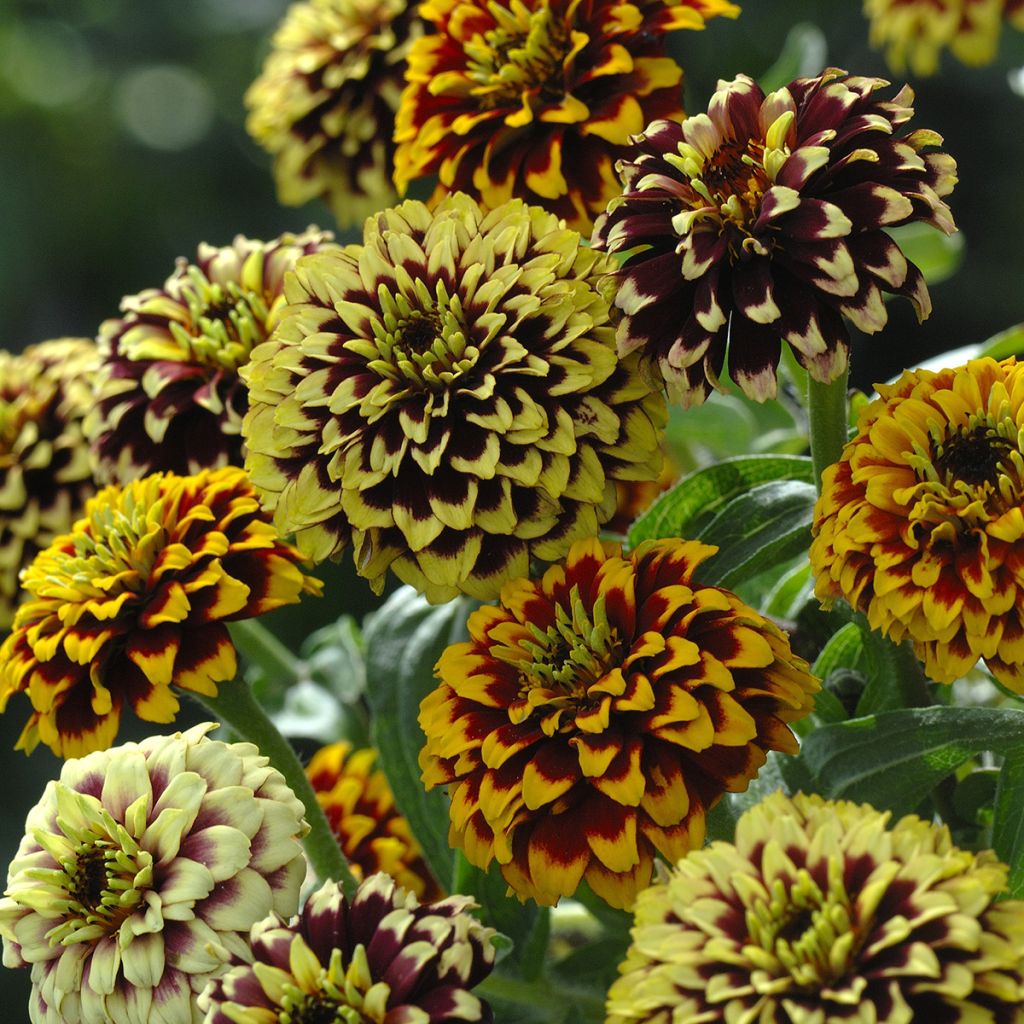

Zinnia haageana Jazzy Mix - seeds
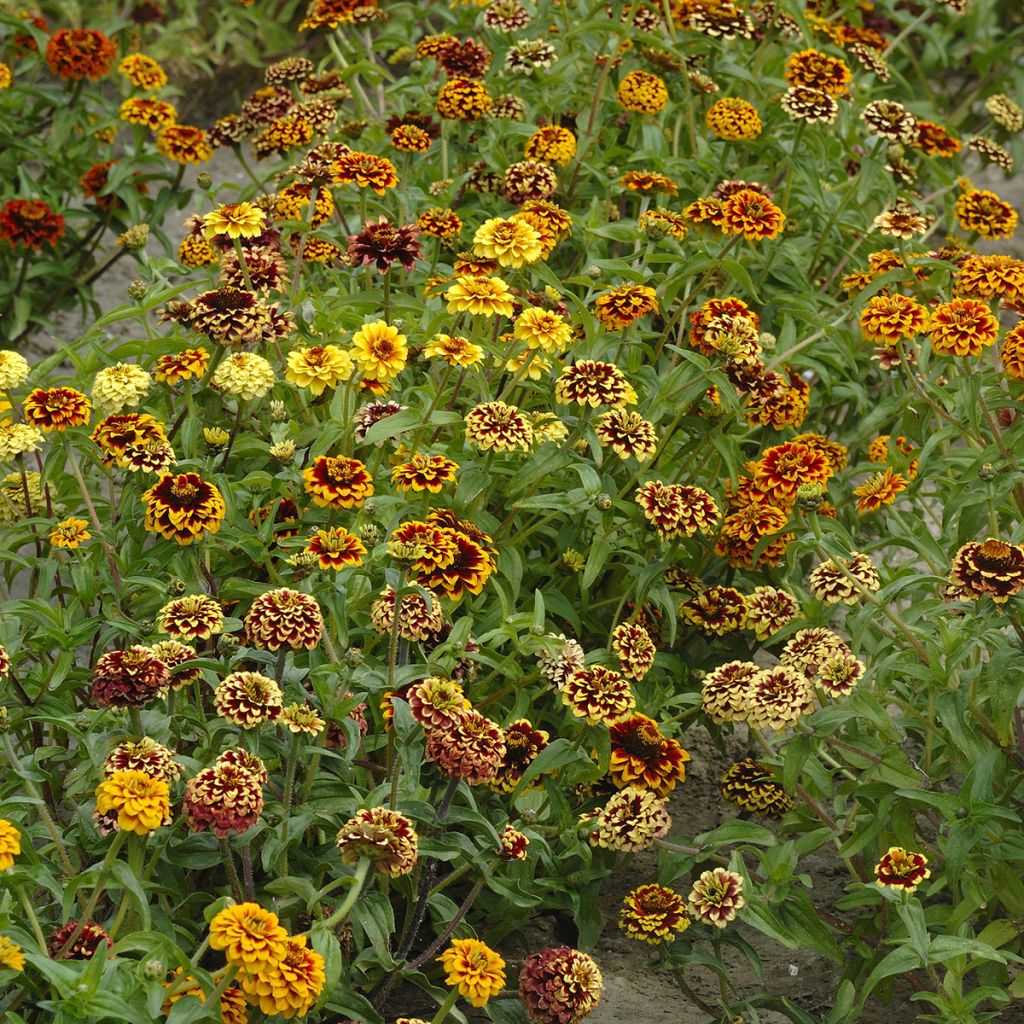

Zinnia haageana Jazzy Mix - seeds
Zinnia haageana Jazzy Mix - seeds
Zinnia haageana Jazzy Mix
Mexican Zinnia, Narrow-leaved Zinnia, Haage's Zinnia
This item cannot be shipped to the selected country
Dispatch by letter from €3.90
More information
Schedule delivery date,
and select date in basket
This plant carries a 6 months recovery warranty
More information
We guarantee the quality of our plants for a full growing cycle, and will replace at our expense any plant that fails to recover under normal climatic and planting conditions.
Seed-only orders are dispatched by sealed envelope. The delivery charge for seed-only orders is €3.90.
Does this plant fit my garden?
Set up your Plantfit profile →
Description
The Zinnia haageana 'Jazzy Mix' offers small flowers like fireworks, in different highly contrasting bicolour duos. Semi-doubles or doubles, they come in earthy tones, finished with tips of opposing colours. There are burgundy red, red, yellow and orange with cream, red, or yellow tips. It blooms continuously from summer to autumn in flower beds and borders and brightens up floral arrangements. This annual is easy to grow in the garden. It can be planted in a mix with other equally undemanding flowering plants.
The approximately 20 species that make up the Zinnia genus are native to dry meadows in an area stretching from southwestern North America to South America, but primarily Mexico. Zinnia haageana (Synonym Z. mexicana or Z. angustifolia) is an annual plant that thrives in heat and sunlight, belonging to the aster family, native to Mexico, with small but abundant flowers.
The 'Jazzy Mix' variety forms a small, well-branched clump, averaging 60 cm (24in) high and 40 cm (16in) wide. The hairy, medium-green leaves are narrow and sheathing at the base. The slender stems are often tinged with red near the ground. Nectar-rich flowers appear from July to mid-October in the axils of the leaves, they are semi-double heads, 4 cm (2in) wide, composed of a double row of ligulate petals surrounding a centre of fertile florets which darken as they mature.
Zinnias are appreciated for their ease of cultivation, and rightly so. They also show great resilience in conditions where other plants struggle. Zinnias thrive in sunlight and withstand high temperatures well, as long as they are watered a little. They do best in neutral, rich, well-drained soil, but can tolerate ordinary garden soil. Plant them in ornamental gardens, borders, and flower beds, and the vegetable garden. Combine zinnias with informal, naturally charming plants such as sages, perennial geraniums, coreopsis. The spikes of ornamental grasses mixing with zinnia flowers make a beautiful display. They can also be sown in pots to decorate the terrace in summer. It is a nectar-rich plant that will delight bees and butterflies.
Report an error about the product description
Zinnia haageana Jazzy Mix - seeds in pictures


Flowering
Foliage
Plant habit
Botanical data
Zinnia
haageana
Jazzy Mix
Asteraceae
Mexican Zinnia, Narrow-leaved Zinnia, Haage's Zinnia
Cultivar or hybrid
Other Zinnia seeds
Planting and care
Sow Zinnia seeds directly, from April to May, in loose and warmed soil. Do not bury the seeds too deep (3 mm (0in) is sufficient) and space them 30 cm (12in) apart. Keep the soil moist until germination, which usually takes between 7 and 14 days.
For early flowering, sow from March to April (indoors, at a temperature ranging from 15 to 25° (59 to 77°F)) in a tray filled with good seed compost, kept moist but not waterlogged. When the plants are large enough to handle, transplant them into pots. Gradually acclimatise your Zinnias to cooler conditions for about fifteen days before planting them in the garden, once all risk of frost has passed, 30 cm (12in) apart.
Zinnias thrive in the sun and tolerate high temperatures well, as long as you remember to water them a little. They do best in neutral, rich, well-drained soil but are not demanding and will also tolerate average garden soil. They may occasionally be susceptible to powdery mildew, a nuisance that can be easily avoided by not planting them in confined spaces and taking care not to wet their foliage. Watch out for slugs when planting, as they love to feast on the tender young leaves.
Sowing period
Intended location
This item has not been reviewed yet - be the first to leave a review about it.
Flower seeds
Haven't found what you were looking for?
Hardiness is the lowest winter temperature a plant can endure without suffering serious damage or even dying. However, hardiness is affected by location (a sheltered area, such as a patio), protection (winter cover) and soil type (hardiness is improved by well-drained soil).

Photo Sharing Terms & Conditions
In order to encourage gardeners to interact and share their experiences, Promesse de fleurs offers various media enabling content to be uploaded onto its Site - in particular via the ‘Photo sharing’ module.
The User agrees to refrain from:
- Posting any content that is illegal, prejudicial, insulting, racist, inciteful to hatred, revisionist, contrary to public decency, that infringes on privacy or on the privacy rights of third parties, in particular the publicity rights of persons and goods, intellectual property rights, or the right to privacy.
- Submitting content on behalf of a third party;
- Impersonate the identity of a third party and/or publish any personal information about a third party;
In general, the User undertakes to refrain from any unethical behaviour.
All Content (in particular text, comments, files, images, photos, videos, creative works, etc.), which may be subject to property or intellectual property rights, image or other private rights, shall remain the property of the User, subject to the limited rights granted by the terms of the licence granted by Promesse de fleurs as stated below. Users are at liberty to publish or not to publish such Content on the Site, notably via the ‘Photo Sharing’ facility, and accept that this Content shall be made public and freely accessible, notably on the Internet.
Users further acknowledge, undertake to have ,and guarantee that they hold all necessary rights and permissions to publish such material on the Site, in particular with regard to the legislation in force pertaining to any privacy, property, intellectual property, image, or contractual rights, or rights of any other nature. By publishing such Content on the Site, Users acknowledge accepting full liability as publishers of the Content within the meaning of the law, and grant Promesse de fleurs, free of charge, an inclusive, worldwide licence for the said Content for the entire duration of its publication, including all reproduction, representation, up/downloading, displaying, performing, transmission, and storage rights.
Users also grant permission for their name to be linked to the Content and accept that this link may not always be made available.
By engaging in posting material, Users consent to their Content becoming automatically accessible on the Internet, in particular on other sites and/or blogs and/or web pages of the Promesse de fleurs site, including in particular social pages and the Promesse de fleurs catalogue.
Users may secure the removal of entrusted content free of charge by issuing a simple request via our contact form.
The flowering period indicated on our website applies to countries and regions located in USDA zone 8 (France, the United Kingdom, Ireland, the Netherlands, etc.)
It will vary according to where you live:
- In zones 9 to 10 (Italy, Spain, Greece, etc.), flowering will occur about 2 to 4 weeks earlier.
- In zones 6 to 7 (Germany, Poland, Slovenia, and lower mountainous regions), flowering will be delayed by 2 to 3 weeks.
- In zone 5 (Central Europe, Scandinavia), blooming will be delayed by 3 to 5 weeks.
In temperate climates, pruning of spring-flowering shrubs (forsythia, spireas, etc.) should be done just after flowering.
Pruning of summer-flowering shrubs (Indian Lilac, Perovskia, etc.) can be done in winter or spring.
In cold regions as well as with frost-sensitive plants, avoid pruning too early when severe frosts may still occur.
The planting period indicated on our website applies to countries and regions located in USDA zone 8 (France, United Kingdom, Ireland, Netherlands).
It will vary according to where you live:
- In Mediterranean zones (Marseille, Madrid, Milan, etc.), autumn and winter are the best planting periods.
- In continental zones (Strasbourg, Munich, Vienna, etc.), delay planting by 2 to 3 weeks in spring and bring it forward by 2 to 4 weeks in autumn.
- In mountainous regions (the Alps, Pyrenees, Carpathians, etc.), it is best to plant in late spring (May-June) or late summer (August-September).
The harvesting period indicated on our website applies to countries and regions in USDA zone 8 (France, England, Ireland, the Netherlands).
In colder areas (Scandinavia, Poland, Austria...) fruit and vegetable harvests are likely to be delayed by 3-4 weeks.
In warmer areas (Italy, Spain, Greece, etc.), harvesting will probably take place earlier, depending on weather conditions.
The sowing periods indicated on our website apply to countries and regions within USDA Zone 8 (France, UK, Ireland, Netherlands).
In colder areas (Scandinavia, Poland, Austria...), delay any outdoor sowing by 3-4 weeks, or sow under glass.
In warmer climes (Italy, Spain, Greece, etc.), bring outdoor sowing forward by a few weeks.


































